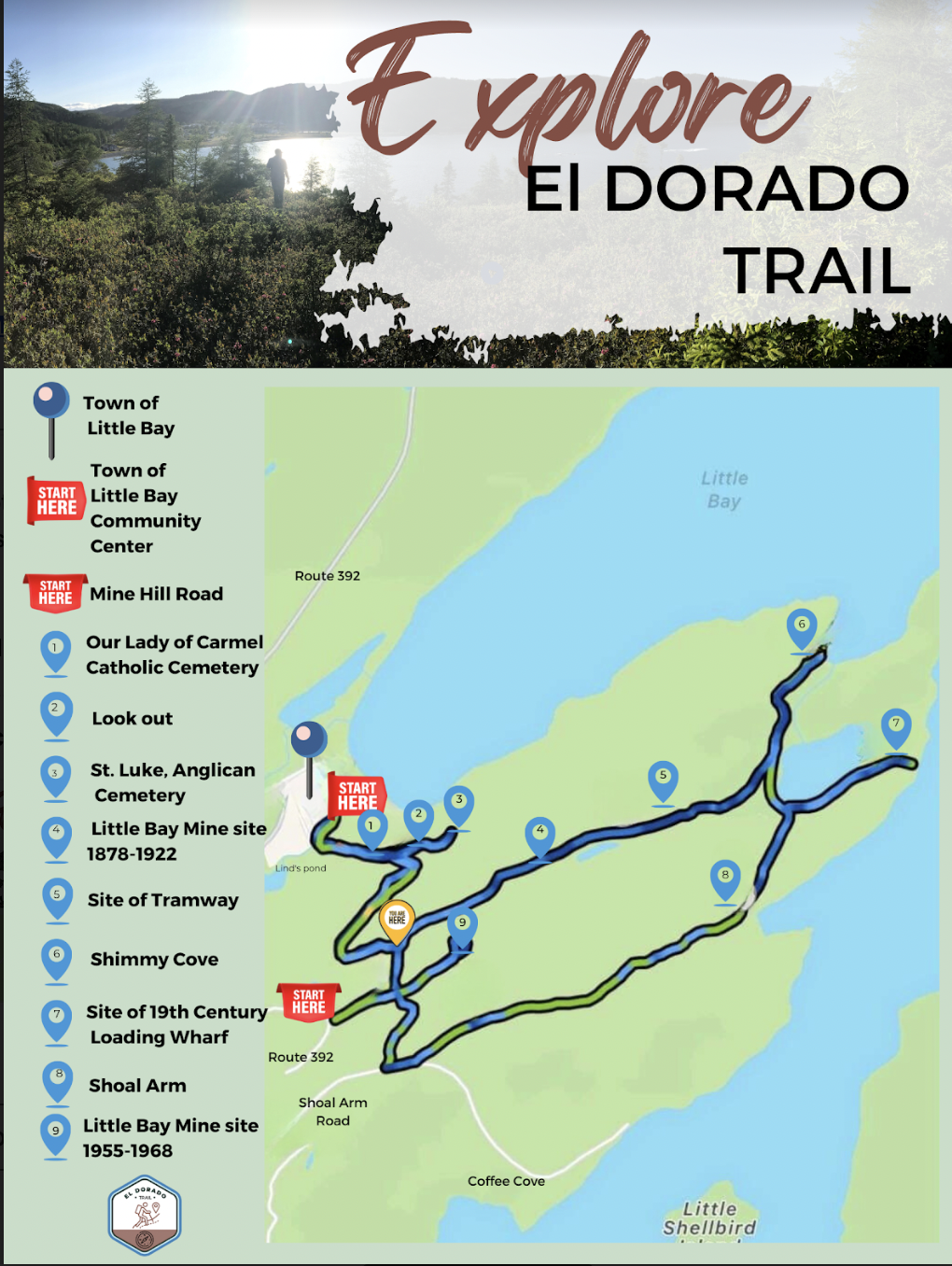
As you may know the town of Little Bay has been working tirelessly for the past year to share its history with you. I hope you’ll explore the town’s new heritage hiking trail – the El Dorado and support Little Bay by celebrating their first Heritage Day on August 12th.
I can’t take any credit for organizing events or building the hiking trail. Little Bay’s Trail Committee and Heritage Society deserves much praise for all of that so make sure to give them the thanks and respect and everything. I hope my research helped!
My work on the town was inspired by a few particular authors. Those that addressed historic Little Bay or related Newfoundland mining. I’m grateful that they’ve been so supportive of this project over the years. I reached out to let them know all that Little Bay has recently accomplished. Below are their statements to the town.
“Congratulations on your first heritage day celebrating the historic copper-mining town of Little Bay, and the opening of the El Dorado Trail” – Gail Hussey-Weir, author of The Miners of Wabana and the historic-wabana.com website.
“Congratulations to the town of Little Bay on uncovering your fascinating history and applying it to make the El Dorado Trail. Good luck with your first Heritage Day” – Felix Perry, author of In Deep Water.
“Making dreams come true takes immense energy, commitment and (yes) love. Congratulations to all involved for realizing their vision of Little Bay’s El Dorado Trail. The project showcases the area’s mining and cultural history in a way that encourages visitors to slip back in time while witnessing some of the most magnificent scenery in Newfoundland” – Gwen Martin, author of Once Upon a Mine.
“I would like to extend congratulations to the town of Little Bay on their first Heritage Day and the establishment of the El Dorado Heritage Trail, both of which record the rich history and culture of your town. And, special acknowledgement to many people in your community, without whose hard work, these heritage projects would not have been realized. In recent years, books have been written and stories have been told about life in your community especially during the heyday of the mining days. On that note, I would like to acknowledge the tireless efforts of Ian Evans whose voracious appetite for the truth has detailed much of the history of your town and the individuals who lived there. Good luck on your special day.” — E. Doyle Wells, author of All Quiet.
The Heritage Day on Aug 12th was originally going to mark the grand opening of Little Bay’s El Dorado Trail but unfortunately the trail isn’t quite ready yet. You can certainly walk it but it needs a few finishing touches before it’s ready for a grand opening. I was asked to come up with a guided tour of the trail for its launch. I realized I had enough information on the town to write the tour from the perspective of someone visiting in 1888 so that’s how I’ve decided to approach it.
It’s not quite done but you’ll get the vibe I’m going for. I’m sharing it now to promote the Heritage Day and also to get your feedback on it. If you think it works I might make it into pamphlets so you can follow the tour of the trail with or without a guide. Anyway, let me know what you think!
El Dorado Trail Tour
 The year is 1888. Little Bay Mines is what everyone has been talking about since it sprang into existence just ten years ago. You’ve heard the talk of all the amazing things its wealth of copper is expected to do to bring Newfoundland into the future.
The year is 1888. Little Bay Mines is what everyone has been talking about since it sprang into existence just ten years ago. You’ve heard the talk of all the amazing things its wealth of copper is expected to do to bring Newfoundland into the future.
Little Bay with its German origins and high fashion. Little Bay with its competitive Cricket team and well stocked Reading Room. It can boast modern technologies like telegraphy and steam engines allowing for world-wide communication and international shipping. Now there are plans to connect this unofficial capitol of the Northern Mining Region to the city of St. John’s with a railway line. You needed to experience the scene yourself. You had to see how it got its nicknames. The place the papers called ‘the gem of the island’ and ‘the El Dorado of Newfoundland’ beckons you.
You watch from the deck of a sailing vessel with other passengers as Little Bay comes into view. Your ship heads toward the government wharf in Little Bay Bight but you can see smoke rising over the hill from Little Bay’s industrial side called Loading Wharf. The noise of machinery there being worked carries over giving a sense of productivity to the otherwise serene scene before you.
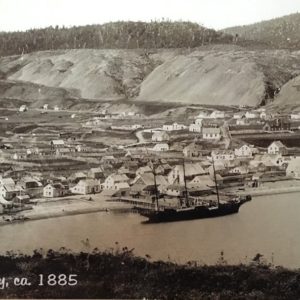 The Bight
The Bight
Little Bay Bight is picturesque. The quaint and orderly village is framed by trees. You first notice the town’s three churches. One located on the beach before you and another two topping the hill to your left. Your ship docks and you disembark alongside other travellers. Standing on the government wharf you face The Bight almost at its centre. You next notice the largest of the town’s buildings clustered before you near the wharf.
You are greeted by the town’s dignitaries including Magistrate Blandford and the Mine Manager Andrew Whyte. They introduce themselves and offer a tour of the town. As you step off the wharf you’re told that the first buildings passed are the Company Cottage and the Telegraph Office. The Cottage was once the home of the town’s founder, the Baron Franz von Ellershausen. You try to follow their history lesson but the scene next door distracts your attention.
Telegraph Office
A large crowd is forming around the office next door. The mail has just arrived. It comes twice a month for half the year but more rarely after the bays freeze for winter. The people push their way to a small window where a visibly frustrated man hands out letters one person at a time. Postmaster Walsh is overworked.
The building has been here since the start. It first doubled as the town’s surgery under Dr. Stafford. It was also the site of Little Bay’s first worship service under Rev. Gunn.
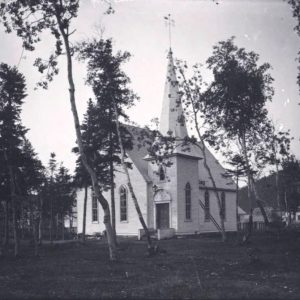 St. Andrew’s
St. Andrew’s
You’re told the church on the beach is called St. Andrew’s. It was the first church built in Little Bay way back in 1879. It was then ran by a Presbyterian but operated as a Free Church. The German sought to keep the place multi-denominational. Reverend Gunn had been hand picked by the Baron and lived with him in the Company Cottage. The first German miners had been Presbyterian but they’d returned home to Ellershouse, Nova Scotia after Little Bay’s mine was sold to an English firm called Mathesons. St. Andrew’s has been used by the town’s Methodists since. That early German practice of mixed denominational worship influences Little Bay’s culture still and is often commented upon by visitors.
Skittle Alley
A little further on stands Little Bay’s infamous Skittle Alley. Nicknamed Lamb’s Corner after its manager John Lamb. He ran the place for Mr. Lindberg the brewer back in St. John’s. Inside patrons would buy drinks and play games. There was a shooting gallery and billiards tables but the game of choice was Skittles which involved tossing a beanbag at a set of pins to knock them over. The men would bet on the outcomes. There’s not much happening there lately. In recent years there has been push back at the establishment and its activities by the town’s growing Temperance Movement. That’s why it’s unoccupied now.
John Lamb introduced the game of Cricket to Little Bay. It quickly became the town’s most popular sport and the Little Bay Pioneers as they are called can draw quite a crowd.
Captain’s Pond
You notice a little pond that appears man-made. In it float the pleasure craft of the town’s wealthier citizens. You’re told they race each other to Little Bay Islands and back during the town’s annual regatta and sometimes just because the town has a noteworthy visitor like the last time the Governor was here. Everyone gathers to watch the races. Father O’Flynn’s boat is the fastest of them all.
Lately people have taken to calling it Captain’s Pond after Mine Captain John Stewart. He is well liked.
Court House
Above the pond is the Court House. It’s part of the Supreme Court on the Northern Circuit. Judge Little visits the town on the HMS Leopard for trials.
The grounds around it are well kept by Little Bay’s police Sergeant Thomas Wells. His gaol here is surprisingly busy lately since the big push against alcohol got going.
Parochial House
Behind the Court is the Parochial House. It has a French roof with dormant windows. The view from its gate is one of the best in town. It overlooks the pond. Father O’Flynn lives there. He has been with the town almost from the beginning and is vital to the society of the place.
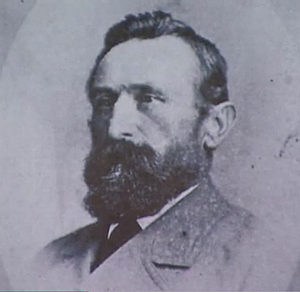 German origins
German origins
While walking from The Bight to Loading Wharf you inquire about Little Bay’s German origins. The town was founded by Baron Ellershausen in 1878 after a hunter named Robert Colbourne had discovered the copper deposit here.
Little Bay was formed almost overnight largely by relocating the first German town on the island – Betts Cove. It went from a wilderness with a population of zero to a functional town of over 500 in just one month. There are 2000 people living here now making it one of the largest spots on the island.
Stairs
In order to ascend the hill separating The Bight from Loading Wharf there are two staircases. One for each of the churches standing above the town. The miners walk them on their route to work and pass their respected places of worship.
There was some concern over the safety of the stairs but we didn’t have much luck getting repairs funded. One night they were vandalized beyond repair and that got us the money to bring them up to speck.
Her Lady of Carmel
Her Lady of Carmel Parish is Little Bay’s Roman Catholic Church. It was the town’s second church. Construction started in 1881 and was completed in 1883 largely by way of donations in St. John’s during performance fundraisers.
It is ran by Father Stephen O’Flynn. He hosts a weekly bazaar which is a big event. It opens with a parade by Little Bay’s Brass Band. They’re pretty good so they draw a crowd. The children follow the band to the bazaar every week.
The Bell in the belfry is called St. Patrick. It’s the work of the blacksmith John Conway. The townsfolk tossed their hard-earned coins into the molten metal as he forged it and you can hear it ringing for miles.
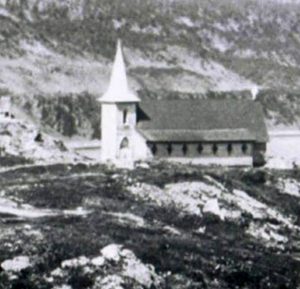 St. Luke’s
St. Luke’s
St. Luke’s is Little Bay’s third church. It’s ran by Rev. Arthur Pittman of the Church of England. It was built in 1885 and paid for by a Fancy Fair here in town. You’ll notice it has a spire. That spire came from Christ Church in Betts Cove. Like St. Andrew’s Christ Church was Presbyterian but ran as a Free Church. That’s the Baron’s influence. The Germans have been gone awhile now but they’re still effecting the culture of this place. You’re not likely to find a Presbyterian spire on an Episcopalian church anywhere else on the island.
Rev. Pittman is a published author and has regular correspondence with the Royal Museum. He sends them native artefacts that people dig up around here. Little Bay used to be called Indian Bight. James Howley was here before the town started and he said you could see the spots where they used to live.
Little Bay Mine
Little Bay mines is one of the largest copper mining operations in the world. It is expected to change Newfoundland’s economic future. That’s why we see so many colonial big-wigs visiting lately.
Little Bay is a Company Town so the quality of life in the town is the responsibility of the Mining Company. That’s why the Baron strived for mixed denominational services and made education everyone’s priority here.
It comes down to the the quality of the Mine Manager. We’ve certainly seen what happens when the wrong man is in charge but that’s behind us. Today Little Bay is the best it has ever been.

Tramway
This Tramway is important to us. The Englishman Dr. Henry Eales worked with the Germans in Betts Cove. He designed the Tramway for the mine there. He was the one the Baron sent to get the ore’s location off of Robert Colbourne. He got it for next to nothing so they hit the ground running making Little Bay that summer back in 1878.
Dr. Eales was here in the beginning and one of the first things operational here was his Tramway. It runs three quarters of a mile connecting the mine to Loading Wharf.
The volume of ore that has travelled these tracks would astound you. We used to have to ship it off to Wales to be smelted but that’s all done right here thanks to some help from New Jersey. The smelting department is ran by William Mallifont. Mathesons sent him 30 men from the city of Bayonne to teach the men here how to do it all local. George Thomson, our analytical chemist, has greatly improved the quality resulting. All that copper is shipped out of here by steamship but to do that it all has to travel this Tramway from the mine to the Loading Wharf. We owe Dr. Eales a debt for that.
Stafford’s Town
Stafford’s Town is better known by its nickname. Most of the locals call it Chemist Cove on account of it being named for Little Bay’s first doctor. Dr. Stafford left awhile back and opened a chain of drug stores. Hence the nickname.
Today this is the site of the Salvation Army Barracks. The Salvation Army had a rough go of it here. Believe it or not they built their first spot on a barge out on the harbour because the Company would’t give them any land.
This is also where the McLeans provide the bay with their notorious rum-running operation. Those two certainly keep Sergeant Wells on his toes trying to catch them.
Loading Wharf
Loading Wharf is the biggest of Little Bay’s districts. It has more people than The Bight. It’s named, obviously, because the mine’s Loading Wharf is here. This is something to behold. It’s an advanced industrial site operating to smelt ore from the mine and load it on steamships set for Swansea in Wales. This is some of the most advanced wharfage in the world and it can accommodate several steamships at once.
You look across the way and see a pier on Otter Island. That’s where the Benson’s live. There are rumours that Mr. Benson was hiding rum in his salt stores for the McLeans. Can’t know for sure. All I can say for sure is that he runs the Provisional Store here and owns a few fishing schooners.
Shoal Arm
Our final stop before we make our way back is Shoal Arm. Shoal Arm is another of the districts of Little Bay Mines. Like most of them it started back in 1878 when the whole area went from hosting no-one to accommodating hundreds overnight. The most prominent family present are the Boyles. B.T. Boyles is a respectable fellow. He runs one of the town’s better shops.
This ends our tour but before you make your way back to The Bight I’ll tell you this is only a glimpse of everything going on around here. You still haven’t seen half The Bight yet. There’s Little Bay’s Reading Room, The Hotel, and The Public Hall. There are also other districts of Little Bay Mines like Colbourne’s Cove and St. Patrick’s. Maybe we’ll take you on another tour to see the rest of it on your next visit. Everyone comes back to Little Bay. The colony’s future is found in our copper and its a bright future. They don’t call us the El Dorado of Newfoundland for nothing!
